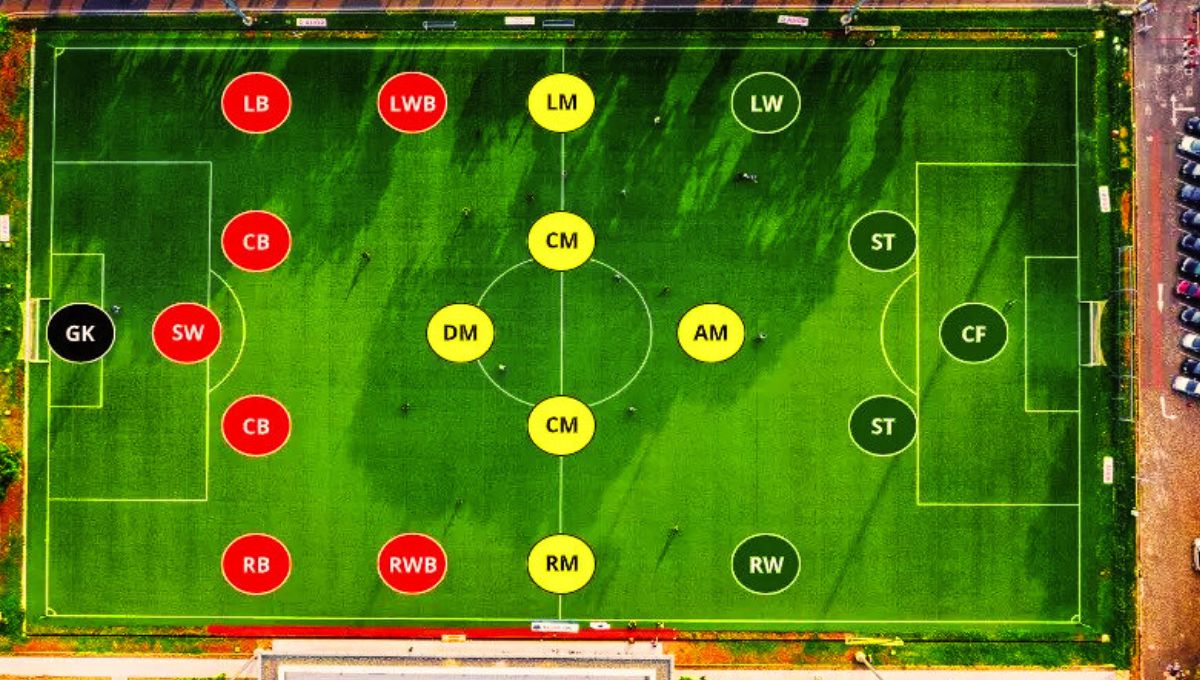One of the most fascinating aspects of football is the variety of roles players take on during a match.
Each position has unique responsibilities and requires specific skills.
In this guide, we’ll break down all the key football positions and explain what makes each one special.
Different Positions in Football
1. Goalkeeper (GK)
The goalkeeper is the ultimate last line of defense.
Their main job is to stop the ball from crossing the goal line and prevent the opposing team from scoring.
A great goalkeeper needs:
- Fast reflexes
- Exceptional agility
- Courage to dive into crowds and challenge attackers
- Good communication with defenders is crucial, as the goalkeeper directs the backline from their vantage point.
Check out all the goalkeeper rules and detailed guide here.
2. Defenders
Defenders are primarily tasked with protecting their team’s goal and stopping opposing attackers.
Types of Defenders:
- Center-Backs (CB):
Positioned centrally, they are often tall, strong, and dominant in aerial duels. They organize the defense and neutralize the opposition’s main strikers. - Full-Backs (RB/LB):
These defenders cover the right (RB) and left (LB) flanks. They defend against wingers and also support attacks by delivering crosses from wide areas. - Wing-Backs (RWB/LWB):
A hybrid between full-backs and wingers, wing-backs are more attack-minded and operate further up the pitch.
3. Midfielders
Midfielders are the engine of the team, controlling the flow of the game from the center of the field. Their role depends on their position:
Types of Midfielders:
- Defensive Midfielders (CDM):
Positioned just ahead of the defense, they break up opposition attacks and protect the backline. - Central Midfielders (CM):
True all-rounders. They help both in defense and attack, dictating the pace and linking play. - Attacking Midfielders (CAM):
These creative players operate just behind the forwards, providing killer passes and often scoring goals themselves.
4. Wingers (RW/LW)
Wingers play wide near the sidelines and are usually quick, skillful dribblers.
Their job is to:
- Stretch the opposition’s defense
- Deliver crosses into the box
- Cut inside to shoot or pass
Wingers can change the outcome of games with their pace and flair.
5. Forwards (Strikers)
The primary goal-scorers of the team.
Forwards need:
- Excellent positioning
- Clinical finishing
- Calmness under pressure
Strikers are often the players who get the most glory because they turn chances into goals.
Full List: Names of All Football Positions
There are 17 commonly recognized positions on a football field:
- Goalkeeper (GK)
- Center-Back (CB)
- Right-Back (RB)
- Left-Back (LB)
- Right Wing-Back (RWB)
- Left Wing-Back (LWB)
- Central Defensive Midfielder (CDM)
- Central Midfielder (CM)
- Left Midfielder (LM)
- Right Midfielder (RM)
- Central Attacking Midfielder (CAM)
- Right Winger (RW)
- Left Winger (LW)
- Center Forward (CF)
- Left Forward (LF)
- Right Forward (RF)
- Striker (ST)
Key Roles Explained Further:
Goalkeeper (GK)
The goalkeeper’s job is simple: keep the ball out of the net.
There’s no real variation in this position. However, some goalkeepers, known as “sweeper keepers” (like Manuel Neuer), are also skilled at playing with their feet and act almost like an extra defender when needed.
Watch how sweeper-keepers play:
Defenders
- Right-Back (RB) and Left-Back (LB):
Positioned on either side of the defense, they balance defending and supporting the attack. - Center-Backs (CB):
Core defenders positioned centrally, battling strikers and clearing dangerous balls.
Midfielders
- CDM (Central Defensive Midfielder):
Protects the defense by intercepting attacks. - CM (Central Midfielder):
Links defense and attack with passing and movement. - LM/RM (Left/Right Midfielder):
Combines midfield responsibilities with wide play, supporting both attack and defense. - CAM (Central Attacking Midfielder):
The creative heart of the attack, setting up strikers and scoring themselves.
Forwards
- Right/Left Winger (RW/LW):
Wide attackers who create chances with pace and dribbling. - Center Forward / Striker (CF/ST):
The main goal scorers who lead the line.
FAQs About Football Positions
1. What is the Number 8 Position?
The number 8 is the Central Midfielder (CM)—a dynamic player who helps in both attack and defense.
Key qualities of a number 8:
- Strong passing range
- Excellent stamina
- Good defensive and attacking skills
Famous Number 8s: Steven Gerrard, Frank Lampard, Andrés Iniesta.
Current Stars: Toni Kroos, Martin Ødegaard, Pedri.
2. What’s a False 9 vs a Number 9?
False 9:
A striker who drops deeper into midfield to create space and link play.
- Famous examples: Lionel Messi (Barcelona), Francesco Totti (AS Roma).
Number 9:
A classic center-forward focused solely on scoring goals.
- Famous examples: Ronaldo Nazário, Gabriel Batistuta, Robert Lewandowski.
Which is better?
Both roles are effective depending on a team’s style and tactics. A coach must pick the system that best suits their players.
3. What is the Number 10 Role?
The Number 10 is the attacking playmaker—a creative magician pulling the strings just behind the striker.
Key responsibilities:
- Creating goal-scoring chances
- Dictating the tempo in the final third
- Scoring goals
Famous Number 10s: Diego Maradona, Pelé, Zinedine Zidane, Lionel Messi.
In modern football, the classic Number 10 role has evolved, but creativity remains its core.
Before You Go…
Want to deepen your football knowledge even more?
👉 Check out our guide to the 17 Basic Rules of Football and take your understanding to the next level!
